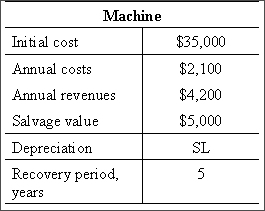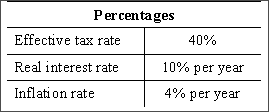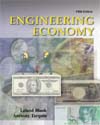Contributed by
Dr. Jeffrey Adler, P. E.- MindBox, Inc.
(formerly of Civil Engineering Rensselaer Polytechnic Institute)
How to use this section: Each exercise requires the development of an Excel spreadsheet. The exercises are keyed to sections in the text Engineering Economy, 5th edition, by Blank and Tarquin. Appendix A of the text is a complete primer for using Excel and the financial functions pertinent to engineering economic analysis. Sample problems are included in this appendix for setting up each function. The spreadsheet exercises presented here are especially well suited to an engineering economy course with laboratory sessions or activities that help a student become more adept with spreadsheet-based solutions. Spreadsheet Exercise #12After-Tax Cash Flow Determination with Inflation Adjustment: The Final Exam Exercise Objective: This exercise pulls together several concepts from Level Four of the text. If you can set up and solve this problem, you are ready for the big time!! Blank and Tarquin Text Reference: Chapters 14, 16, and 17. Problem Statement: The Washington Tribune seeks to purchase a new printing machine. The estimated costs in today's (actual, constant-value) dollars are  <a onClick="window.open('/olcweb/cgi/pluginpop.cgi?it=gif::Machine Costs::/sites/dl/free/0072432349/22724/ex12a.gif','popWin', 'width=281,height=227,resizable,scrollbars');" href="#"><img valign="absmiddle" height="16" width="16" border="0" src="/olcweb/styles/shared/linkicons/image.gif">Machine Costs (2.0K)</a>Machine Costs <a onClick="window.open('/olcweb/cgi/pluginpop.cgi?it=gif::Machine Costs::/sites/dl/free/0072432349/22724/ex12a.gif','popWin', 'width=281,height=227,resizable,scrollbars');" href="#"><img valign="absmiddle" height="16" width="16" border="0" src="/olcweb/styles/shared/linkicons/image.gif">Machine Costs (2.0K)</a>Machine Costs <a onClick="window.open('/olcweb/cgi/pluginpop.cgi?it=gif::Percentages::/sites/dl/free/0072432349/22724/ex12b.gif','popWin', 'width=285,height=128,resizable,scrollbars');" href="#"><img valign="absmiddle" height="16" width="16" border="0" src="/olcweb/styles/shared/linkicons/image.gif">Percentages (1.0K)</a>Percentages <a onClick="window.open('/olcweb/cgi/pluginpop.cgi?it=gif::Percentages::/sites/dl/free/0072432349/22724/ex12b.gif','popWin', 'width=285,height=128,resizable,scrollbars');" href="#"><img valign="absmiddle" height="16" width="16" border="0" src="/olcweb/styles/shared/linkicons/image.gif">Percentages (1.0K)</a>PercentagesThe company is considering two alternative financing strategies for acquiring the machine, a lease plan and a purchase plan, as follows: - Lease for $8000 per year with no money down.
- $5000 down payment from retained earnings and the balance of the first cost on an interest payment loan. Secure a loan that calls for interest payments in each of 5 years at 8% per year of the full loan amount and a single balloon payment of the entire principal at the end of year 5.
Problem Statement: Set up a spreadsheet that analyzes the cash flow after taxes (CFAT) using the present worth method. Include all tax, inflation, depreciation, and interest implications. Which option is better? |



 2002 McGraw-Hill Higher Education
2002 McGraw-Hill Higher Education
